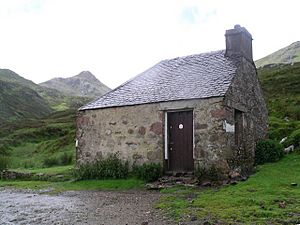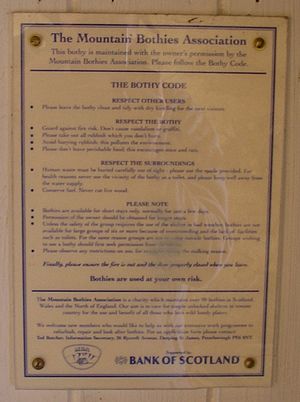Bothy facts for kids

A bothy is a simple, free shelter found in wild, remote places. Think of it like a basic cabin or hut that's always open for anyone to use. People often find bothies in the mountains of Scotland, Northern England, Northern Ireland, Wales, and the Isle of Man. They are super common in the Scottish Highlands! Similar shelters exist in other parts of the world, like wilderness huts in Nordic countries. Long ago, the word "bothy" also described basic homes for workers on large estates, like gardeners.
Contents
What Does "Bothy" Mean?
Where did the word bothy come from? Nobody is completely sure! It might be linked to words like bothán in Irish or Scottish Gaelic, which mean "hut." It could also come from the Welsh word bwthyn, meaning "small cottage." Another idea is that it comes from an old Norse word, būð, which is similar to the English word "booth."
What Are Bothies Like?
Most bothies were once old, ruined buildings that volunteers have fixed up. They are made to be windproof and watertight, offering a safe place to stay. Bothies come in different sizes, from small huts to two-story cottages.
They usually have special areas for sleeping, often an upstairs room or a raised platform. This helps you stay away from cold air on the floor. Remember, bothies do not provide bedding, mattresses, or blankets, so you need to bring your own! You can usually reach bothies by walking, cycling, or sometimes by boat.
Most bothies have a fireplace to keep warm and are close to a natural source of water. Sometimes, you might find a spade there to help you properly bury human waste away from the bothy and water sources.

Famous Bothy Examples
There are many bothies across the UK. For example, in Scotland, there's the Salmon Fisherman's Bothy in Newtonhill. It sits high above the Burn of Elsick where it meets the North Sea. Another Scottish example is the fisherman's bothy at the mouth of the Burn of Muchalls. The Lairig Leacach Bothy in Lochaber, near Fort William, is also a well-known one.
Bothies on Estates
Some bothies were built on large estates, like castles or big country homes. These were used to house single men who worked there, such as gardeners. If a worker got married, they usually had to move out of the bothy.
A famous example is the bothy at the Royal Gardens at Windsor Castle. It was big enough for about 25 people, including gardeners and disabled ex-servicemen. Percy Thrower, a very famous gardener, once lived in a bothy like this when he worked at the Royal gardens. Other estates, like Horwood House and Attingham Park, also had bothies for their workers.
The Bothy Code
Bothies are free for everyone to use, but they need our help to stay open. The Mountain Bothies Association (MBA) created the Bothy Code. This code has important rules that users should follow to keep bothies in good condition:
- You use bothies at your own risk.
- Always leave the bothy clean and tidy. Make sure there's dry kindling (small sticks for starting a fire) for the next visitors. Be friendly and welcoming to other people using the bothy.
- If you see any damage, report it to the people who look after the bothy.
- Take all your rubbish with you, especially things that can't burn. Burying rubbish pollutes the environment. Don't leave food that can spoil, as it attracts pests.
- Be very careful with fire! Make sure the fire is completely out before you leave.
- Always close doors and windows properly when you leave.
- If there's no toilet, bury human waste far away from the bothy and any water sources. Never use the area right around the bothy as a toilet.
- Never cut down live trees or damage property on the estate. Use firewood wisely.
- Bothies are for small groups who are traveling through the mountains, not for large groups or long stays.
- Respect any rules about when you can use the bothy, for example, during hunting season or when lambs are being born.
- Bothies are for short stays only. If you plan to stay for a long time, you must ask the owner for permission first.
- Large groups (6 or more people) should not use a bothy or camp nearby without asking the owner first. Bothies are not for commercial groups (like tour companies).
Who Owns Bothies?
Bothies are usually owned by the landowner of the estate where they are located. The owner often allows the bothy to exist and might help with moving building materials. Many bothies are looked after by volunteers from the Mountain Bothies Association (MBA). The MBA is a charity that cares for 97 bothies in Scotland, northern England, and Wales.
You can find the locations of these bothies and information on how to help on the MBA website.
See also
In Spanish: Chozo para niños

